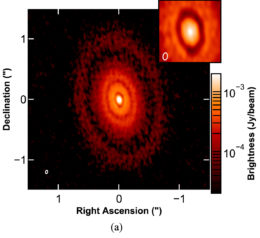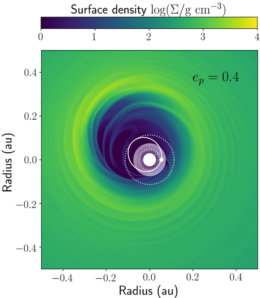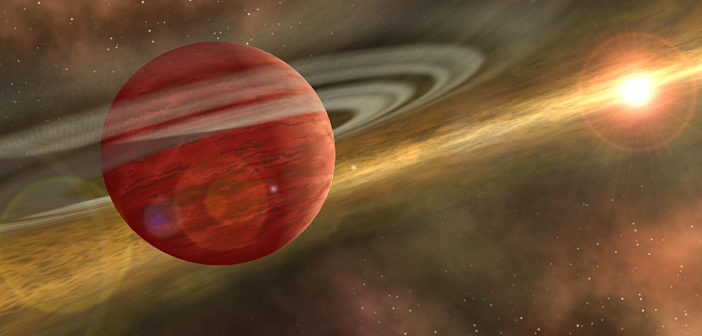CI Tauri is thought to host a massive planet roughly five times closer than Mercury is to the Sun, but observations reveal ample radiation arising from gas and dust close to the star — gas and dust that we would expect to be missing if a planet were present. Can astronomers explain these conflicting observations?

Synthesized image of CI Tau continuum observations, revealing three annular gaps between 10 and 100 AU. The inset shows a 0.35”-wide zoom on the innermost gap, imaged with a finer resolution. [Clarke et al. 2018]
Protoplanetary Problems
At just 2 million years old, CI Tauri already has a 12-Jupiter-mass planet, CI Tau b, orbiting at just 0.08 au, and three additional giant planets potentially lurk in CI Tauri’s disk at tens of au. Curiously, though, the system’s spectral energy distribution — the amount of energy emitted as a function of wavelength — lacks the tell-tale sign of a close-in massive planet: a dip in the amount of near-infrared emission, which is produced by warm gas and dust.
Much of the 1–10-μm radiation from a protoplanetary disk arises from the material closest to the star, so a decrease in emission at these wavelengths is usually taken as a sign that a close-in planet is busily scooping up gas and dust to carve out a gap in the disk material. However, observations of CI Tauri suggest that a planet could be present without changing the near-infrared emission. To test this, Dhruv Muley and Ruobing Dong (University of Victoria, Canada) used hydrodynamic and radiative transfer modeling to understand the conditions under which a close-in planet will affect the system’s spectral energy distribution.

An example simulation of a planet (smaller white circle) with an orbital eccentricity (ep) of 0.4. The color indicates the particle density and the dotted lines show the regions where the planet is able to accrete material. [Adapted from Muley & Dong 2021]
Disks, Dust, and Distributions
The authors first modeled a disk with no planets present, matching the model output to the observations of CI Tauri as closely as possible. Next, they introduced a CI Tau b-sized planet into the simulation and gave it time to carve a swath through the disk before comparing the outcomes for a range of orbital distances and eccentricities. Muley and Dong found that planets with more elliptical orbits create gaps that are wider, since they’re able to collect material within a larger range of radii, but the material that remains in the gap is denser than it would be in the case of a planet with a perfectly circular orbit.
The authors then used their hydrodynamic simulations to generate a spectral energy distribution for each set of conditions. They found that a planet at CI Tau b’s orbital distance of 0.08 au doesn’t remove enough material to induce the tell-tale dip in the near-infrared emission, regardless of its eccentricity, which is consistent with the observations.

Simulated spectral energy distributions showing the effects of the planet’s orbital distance (ap; varies between panels) and eccentricity (ep; varies with line color). [Muley & Dong 2021]
Impactful Conditions
However, a CI Tau b-size planet placed slightly farther from the star — say, 0.26 or 0.40 au — makes its presence known in the resultant spectral energy distribution. The more distant planets deplete the disk material enough to decrease the 1–10-μm emission and open gaps wide enough to reveal the hot inner wall of the gap, which increases the emission at 10–100 μm.
The authors’ simulations show that the presence of a close-in planet isn’t at odds with CI Tauri’s spectral energy distribution, and more generally, a lack of typical planetary indicators might not signal a lack of planets. Since spectral energy distributions are one of our most powerful tools for studying protoplanetary disks, it’s crucial to understand their intricacies in order to trust our interpretations.
Citation
“CI Tau: A Controlled Experiment in Disk–Planet Interaction,” Dhruv Muley and Ruobing Dong 2021 ApJL 921 L34. doi:10.3847/2041-8213/ac32df

